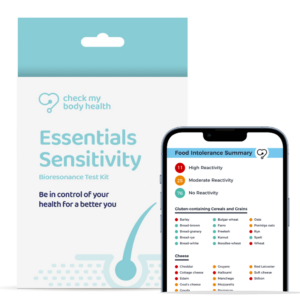
Medically reviewed by Sian Baker, Dip ION mBANT mCNHC
on April 9, 2024. To give you technically accurate, evidence-based information, content published on the Check My Body Health blog is reviewed by credentialed professionals with expertise in medical and bioscience fields.
Signs & Symptoms of a Lupin Intolerance or Allergy
If you experience symptoms like hives, digestive issues, respiratory problems, or in severe cases difficulty breathing after eating foods that may contain lupin, you could have a lupin allergy or intolerance. Lupin is a legume increasingly used in gluten-free and vegan products.
The symptoms of a lupin allergy can range from mild to severe and include:
- Itchy Skin Rash (hives or urticaria): These are common and can appear anywhere on the body.
- Gastrointestinal symptoms: These include abdominal pain, nausea, vomiting, and diarrhoea.
- Respiratory symptoms: Sneezing, coughing, wheezing, and difficulty breathing are typical if the airways are affected.
- Anaphylaxis: This severe reaction can cause swelling of the throat, difficulty breathing, a sudden drop in blood pressure, dizziness, and loss of consciousness. Immediate medical attention is necessary.
What are the symptoms of lupin intolerance?
Lupin intolerance typically involves digestive issues such as bloating and gas, which result from the body’s inability to fully digest lupin beans. Unlike an allergy, intolerance does not involve the immune system.
What is food intolerance?
Food intolerance occurs when your body cannot properly digest a particular food, leading to gastrointestinal discomfort such as bloating, gas, and diarrhoea. It’s important to note that while food intolerances can cause significant discomfort, they are generally not life-threatening.
How common is lupin intolerance?
Lupin intolerance is less documented than lupin allergies, but it may occur in individuals who consume large amounts of lupin, particularly in regions where it is a common part of the diet. Unlike allergies, intolerances do not involve an immune response and are generally less severe.
How do you test for a lupin allergy or intolerance?
Diagnosing a lupin allergy or intolerance involves:
- Allergy Testing: Skin prick tests or blood tests can confirm an allergy to lupin.
- Elimination Diet: Removing lupin from your diet and monitoring symptoms can help identify an intolerance.
- Medical Consultation: Always consult with a healthcare provider for accurate diagnosis and management.
What should you do if you think you have a lupin allergy or intolerance?
If you suspect a lupin allergy or intolerance, the best course of action is to avoid consuming lupin and consult a healthcare provider for testing and advice on management. Avoiding lupin can be challenging as it may be present in many gluten-free or health-focused products, so careful label reading is essential.
Unsure about what’s upsetting your gut? Discover your potential food sensitivities with Check My Body Health’s simple, at-home food intolerance test. Get clear, actionable results in just 5 days and take the first step towards a happier, healthier tummy.
What foods should you avoid if you have a lupin allergy or intolerance?
Lupin can be found in various food products, especially in gluten-free and vegan foods. Here are some common sources of lupin:
- Baked goods: Breads, pastries, and pies that may use lupin flour.
- Pasta and noodles: Look for lupin flour or lupin beans listed in the ingredients.
- Processed foods: Lupin may be used as a texturizer or flavour enhancer in processed foods.
To avoid accidental ingestion, always read food labels and inquire about ingredients in restaurants.
10 Alternatives to Lupin
For those who need or want to avoid lupin, especially in gluten-free or vegan diets, there are several alternatives that can be used in various recipes:
- Chickpea Flour: A great alternative for baking and cooking, providing a similar protein content without the risk of lupin allergy.
- Coconut Flour: Low in carbohydrates and high in fibre, suitable for baking.
- Almond Flour: Ideal for those not allergic to nuts, it’s perfect for baking and provides a rich, nutty flavour.
- Soy Flour: High in protein, though it should be avoided by those with soy allergies.
- Rice Flour: A common substitute in gluten-free products that is generally well tolerated.
- Oat Flour: Make sure it’s labelled gluten-free to avoid cross-contamination, excellent for baking.
- Quinoa Flour: A complete protein, good for adding nutrition to dishes.
- Tapioca Flour: Good for baking and thickening sauces or soups.
- Potato Starch: Great for thickening without altering flavour.
- Cornstarch: A versatile thickener and good for creating a crispy coating in frying recipes.
These alternatives not only provide different nutritional benefits but also help those with lupin allergies to diversify their diet without feeling restricted.
How to test if you have a lupin allergy or intolerance
If you suspect that you might be allergic or intolerant to lupin, it’s important to confirm this with accurate testing to manage your diet effectively. Here are a few steps you can take:
- Consultation with an Allergist: An allergist can perform specific tests, like skin prick tests or blood tests, to determine if you have an allergy.
- Elimination Diet: Temporarily remove lupin and products containing lupin from your diet to see if symptoms improve.
- Food Diary: Keep a detailed record of what you eat and any symptoms you experience to help identify patterns and potential triggers.
For those who have been diagnosed with a lupin allergy, it is crucial to carry medication such as antihistamines or an adrenaline auto-injector (AAI) in case of accidental exposure leading to severe reactions.
Managing a Lupin Allergy
Managing a lupin allergy involves vigilance and preparedness. Here are some strategies to help avoid lupin and manage reactions:
- Read Labels Carefully: Always check the ingredients list on food packaging for lupin or its derivatives.
- Communicate Dietary Restrictions: Inform restaurant staff and hosts about your allergy when dining out or attending social gatherings.
- Prepare Food at Home: Cooking at home can reduce the risk of accidental exposure to allergens.
- Education and Awareness: Educate yourself and others about lupin allergy, its sources, and how to respond to an allergic reaction.
It’s also beneficial to join support groups and follow updates in food labelling laws, as regulations can change, affecting how allergens like lupin are displayed on packaging.
What’s the link between peanut and lupin allergy?
People with peanut allergies might also be allergic to lupin. This is because lupin and peanuts belong to the same legume family, and their proteins are similar enough to trigger a reaction in some individuals. While not everyone with a peanut allergy will also be allergic to lupin, it’s important to be aware of this potential cross-reactivity, especially if you have severe allergies.
Lupin is becoming more common in gluten-free foods like baked goods and pasta. If you have a peanut allergy and also need to avoid gluten, be extra careful when reading product labels to ensure you don’t accidentally consume lupin and risk a reaction.
Emergency Preparedness
It is critical for those with severe allergies to be prepared for an emergency:
- Carry Emergency Medication: Always have antihistamines and an adrenaline auto-injector (like an EpiPen) with you.
- Medical Alert Accessories: Wear a medical bracelet or necklace that alerts others to your lupin allergy.
- Action Plan: Have a clear action plan for managing an allergic reaction, including knowing when and how to use an adrenaline auto-injector and when to seek medical help.
Being prepared can make a significant difference in the safety and well-being of those with a lupin allergy.
Frequently Asked Questions About Lupin Allergy
Q1: Can lupin allergy be cured?
A1: Currently, there is no cure for lupin allergy. Management involves strict avoidance of lupin in the diet and preparedness to treat allergic reactions should they occur.
Q2: Are there any specific treatments for lupin allergy?
A2: Treatment primarily involves avoiding lupin-containing foods and products. For accidental exposure, antihistamines may be used to relieve mild symptoms. In cases of severe reactions, such as anaphylaxis, an adrenaline auto-injector must be used immediately, and emergency medical help should be sought.
Q3: How do I know if a product contains lupin?
A3: In many countries, lupin is recognized as a major allergen and must be clearly labelled on packaged foods. Always read ingredient lists carefully. If you’re unsure, contact the manufacturer for confirmation.
Q4: Can children outgrow lupin allergy?
A4: Unlike some food allergies, such as milk or egg, which children can outgrow, there is less evidence regarding outgrowing lupin allergy. Ongoing medical advice and regular allergy testing are recommended to monitor any changes in allergy status.
Q5: Is lupin allergy common in children or adults?
A5: Lupin allergy can occur in both children and adults, though it may be diagnosed more frequently in adults due to the increased likelihood of consuming products like gluten-free baked goods that contain lupin.
Lupin Allergies: In Summary
Lupin allergy, while less common than other food allergies, requires careful management and awareness. By avoiding lupin-containing foods, being vigilant about ingredient labels, and being prepared to treat allergic reactions, individuals with lupin allergy can lead safe and healthy lives.
Remember, if you suspect you or someone you know has a lupin allergy, it’s important to seek guidance from a healthcare provider for proper testing and management strategies. For those looking to further understand their sensitivities, consider trying one of Check My Body Health’s intolerance tests, which can provide valuable insights into various food sensitivities and allergies.




